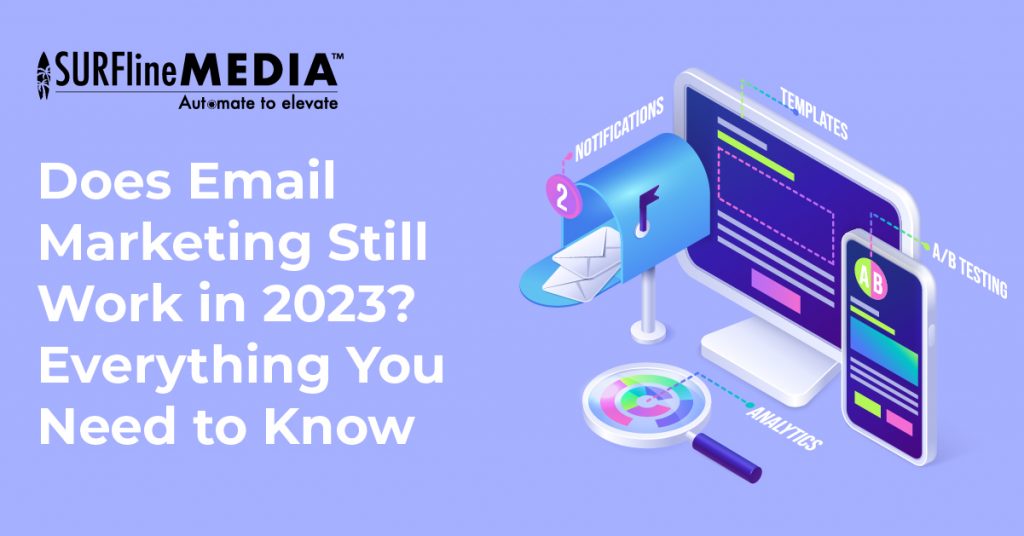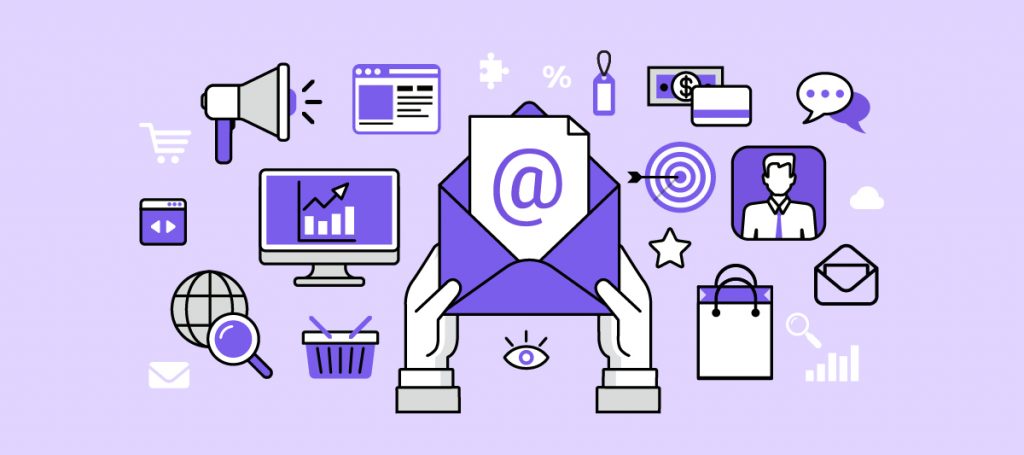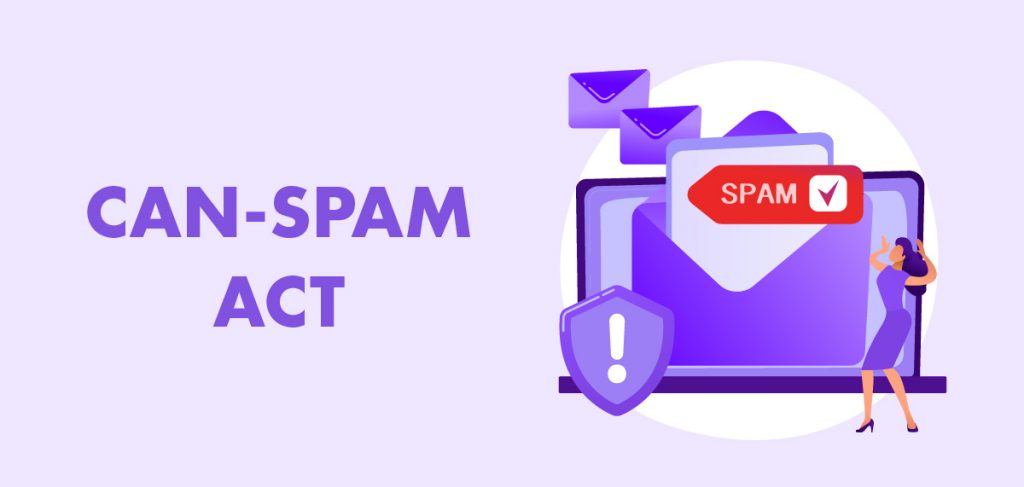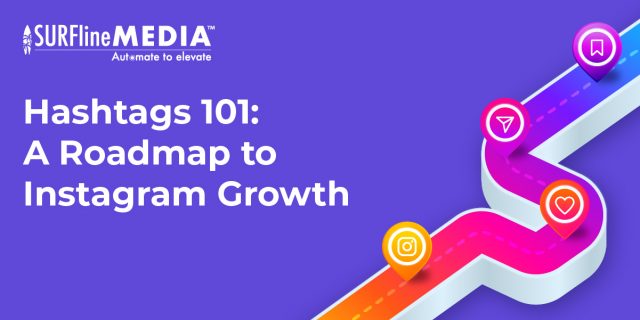

- September 13, 2023
- 4:00 pm
- No Comments
Does Email Marketing Still Work in 2023? Everything You Need to Know
Email marketing has consistently proven itself as a versatile and enduring strategy. As we step into 2023, businesses are presented with new opportunities and challenges in harnessing the power of this communication channel.
In this blog, we’ll explore the evolving changes, emerging statistics, and best practices that will define email marketing’s role in the ever-changing marketing ecosystem of 2023.
1. The Evolution of Email Marketing
What is Email Marketing? The evolution of email marketing has seen it grow from a simple communication tool into a multifaceted and integral aspect of modern marketing strategies. Initially, email marketing was akin to a digital newsletter, where businesses sent out generic messages to a broad audience. However, as digital landscapes evolved, so did email marketing strategies.
Email marketing started to embrace personalization and segmentation. Marketers began to recognize the value of tailoring content to individual preferences and demographics. This shift led to a more relevant and engaging email marketing campaign, fostering stronger connections with recipients.

The advent of mobile devices further shaped email marketing. With the majority of people checking their emails on smartphones, marketers had to optimize their content for smaller screens and touch interfaces. Responsive design became a standard practice to ensure emails were displayed correctly and easy to interact with on mobile devices.
👉 Read more: A Comprehensive Guide to Mobile Marketing (2023)
Interactive elements, such as clickable buttons and dynamic content, also became prevalent. These additions transformed static emails into engaging experiences, allowing recipients to interact directly with the email itself.
Moreover, the incorporation of data analytics and user behavior tracking enabled marketers to gain deeper insights into email performance. They could refine strategies based on metrics like open rates and click-through rates, ensuring ongoing improvement in email marketing campaigns.
2. The Current State of Email Marketing
2.1 2023 statistics
As of 2022, an astounding 4.3 billion people worldwide were using email (Statista, 2021). This number is projected to rise to 4.6 billion by 2025, representing more than half of the expected global population.
Now, let’s delve into some fascinating statistics that underscore the enduring significance and effectiveness of email marketing in the contemporary digital landscape:
- Email Marketing ROI: For every dollar invested in email marketing, businesses can anticipate an impressive average return of $40 (Omnisend, 2022).
- Email Traffic Surge: In 2023, an astonishing average of 347.3 billion emails were sent and received daily—an increase of 4.3% from the previous year. Predictions suggest this trend will persist, with the number reaching 361.6 billion in 2024.
- Lead Generation Dominance: A whopping 89% of marketers regard email as their primary channel for generating leads.
- Open Rate Insights: In 2022, the average email open rate stood at 19.66%, demonstrating the effectiveness of well-crafted subject lines and engaging content.
- High Click-Through Rates: Surprisingly, 22% of marketers reported email click-through rates exceeding 20%, significantly surpassing the industry average of 10.69%.
- Click-to-Open: The average click-to-open rate, a measure of email engagement quality, was a notable 10.5%.
- Minimal Unsubscribe Rate: Encouragingly, the average unsubscribe rate in 2022 was a mere 0.1%, reflecting the relevance of content to subscribers.
- Combatting Spam: The spam rate remained impressively low, averaging at 0.02% in 2022.
- Bounce Rate: Across all industries, the average email bounce rate settled at 2.76%.
- Response Rate Targets: To gauge success, marketers often aim for an average response rate of 10%, emphasizing the importance of crafting compelling email campaigns.
2.2 Email Marketing adapts to the current era
Email marketing has proven its resilience and enduring value in the ever-evolving landscape of digital marketing. Despite the constant emergence of new communication platforms and marketing channels, email marketing continues to adapt and thrive.
One of its key strengths lies in its ability to evolve with technology and consumer preferences. From simple text-based messages, email marketing has embraced multimedia content, responsive design, and personalization. Moreover, data analytics has enhanced email marketing strategies, enabling precise targeting and performance measurement.

Email’s universal accessibility is another factor in its continued success. Almost everyone has an email address, making it a direct and versatile channel for reaching a wide range of audiences.
Additionally, email marketing’s impressive ROI, cost-effectiveness, and ability to nurture customer relationships have solidified its position as a valuable tool for businesses. It remains a cornerstone of digital marketing strategies, providing a reliable means of connecting with customers, generating leads, and driving conversions.
3. Key Elements of a Successful Email Marketing Strategy
3.1. Building a High-Quality Email List
A successful email marketing strategy begins with a solid foundation: a high-quality email list. It’s essential to collect email addresses from individuals who have given explicit consent to receive your emails. This can be done through sign-up forms on your website, social media channels, or during the checkout process. Maintaining list hygiene by regularly removing invalid or inactive addresses is crucial to ensure high deliverability rates and avoid spam traps.

3.2. Compelling and Relevant Content
Content is king in email marketing. Your subscribers should eagerly anticipate your emails because they offer valuable, relevant content. Craft engaging subject lines and email copy that resonate with your audience’s interests and needs. Segment your list to tailor content to specific groups, ensuring that recipients receive messages that align with their preferences.

3.3. Personalization and Targeting
Personalization goes beyond just addressing subscribers by their first name. It involves leveraging data to send highly targeted emails based on user behavior, demographics, and preferences. Implement dynamic content that changes based on recipient data to create a more personalized and engaging experience.
3.4. Effective Design and Layout
Emails should be visually appealing and easy to read across various devices using email marketing tools. Use responsive design to ensure emails adapt to different screen sizes.
Incorporate compelling visuals, such as images and videos, but ensure they enhance the message rather than overwhelm it. A clear and concise layout with a prominent call-to-action (CTA) button helps guide recipients toward your desired action.

3.5. Analyzing and Optimizing
The success of an email marketing strategy hinges on continuous improvement. Regularly analyze key performance indicators (KPIs) like open rates, click-through rates, conversion rates, and unsubscribe rates.
Additionally, you can use A/B testing to refine elements like subject lines, send times, and content to optimize your campaigns. Data-driven decision-making allows you to adapt and improve your strategy over time, ensuring ongoing success in email marketing.
4. Navigating Email Marketing Challenges
4.1. Deliverability and Inbox Placement Challenges
One of the foremost challenges in email marketing is ensuring that your carefully crafted emails actually reach your subscribers’ inboxes. Deliverability issues can occur due to various factors, including spam filters, blacklists, and poorly maintained email lists. It’s essential to maintain list hygiene by regularly removing inactive or invalid addresses and adhering to email marketing best practices to avoid being flagged as spam.

To tackle this challenge, you should focus on using reputable email marketing platforms that have strong deliverability records, authenticating your domain with email authentication methods like SPF and DKIM, and monitoring your sender reputation. Additionally, staying informed about changes in email service provider policies and industry standards can help you navigate the complex landscape of email deliverability.
4.2. Regulatory Compliance and Privacy Concerns
Navigating the intricate web of email marketing regulations and privacy laws is another significant challenge. Legislation like GDPR in Europe and CAN-SPAM in the United States imposes strict requirements on how businesses collect, use, and manage email data. Failure to comply with these regulations can lead to hefty fines and damage to your brand’s reputation.

To address this challenge, businesses must implement transparent consent mechanisms for collecting email addresses, clearly communicate their privacy policies, and provide easy options for subscribers to opt out or update their preferences. Regularly audit your email marketing practices to ensure they align with the latest legal requirements, and seek legal counsel if needed.
4.3. Engagement and Content Relevance
Keeping your email subscribers engaged and interested in your content can be a continuous challenge. Irrelevant or repetitive emails can lead to unsubscribes and decreased open rates. To combat this, segment your email list based on user preferences and behavior to deliver more personalized content. Craft compelling subject lines and email copy that pique curiosity and provide real value to your recipients.
Another challenge is finding the right frequency of email communication. Bombarding subscribers with too many emails can lead to fatigue and opt-outs, while too few emails can result in reduced brand visibility. Achieving the right balance is essential and may require testing different frequencies to determine what resonates best with your audience.
5. The Future of Email Marketing: AI and Automation
The future of email marketing is being significantly shaped by two transformative forces: Artificial Intelligence (AI) and automation. These technologies are revolutionizing how businesses engage with their audiences and personalize their email campaigns.
AI’s role in email marketing is particularly noteworthy. Machine learning algorithms analyze vast amounts of user data to predict customer preferences, optimize send times, and even generate personalized content. This leads to highly targeted and relevant emails, increasing open rates and conversions.
Automation, on the other hand, streamlines repetitive tasks. Drip campaigns, automated responses to user actions, and behavior-triggered emails are becoming commonplace using email marketing software. This not only saves time but also ensures timely and contextually appropriate communications.
Furthermore, AI-driven chatbots and virtual assistants are increasingly integrated into email marketing, offering instant responses to user inquiries and enhancing customer service.

6. Conclusion
In conclusion, email marketing in 2023 continues to be a vital tool for businesses seeking to engage with their audience, generate leads, and drive conversions. With the integration of advanced personalization, AI-driven insights, and seamless automation, email campaigns are becoming more targeted and effective than ever before.
As we move forward, staying abreast of these evolving trends and adapting to the changing landscape will be paramount for businesses aiming to make the most of this enduring marketing channel. Email marketing isn’t fading away; it’s evolving and thriving in the digital age. Contact Surfline Media, a leading email marketing agency, to harness the potential of email marketing.
_______________________

Surfline Media – Automate to Elevate
Our website: https://surflinemedia.com/
Contact us: https://surflinemedia.com/contact-us/
Phone number: +1 323-741-4482
Email: [email protected]






